THE GOLDEN
R A T I O
NEW SITE
HPTGN.TRIPOD.COM
I'm not going to go into much detail about the golden ratio.
If you look around you, you'll see that everything is based on the Golden Ratio. Measure the ratio of your fingerbones or the ratio of your head. It's always the Golden Ratio!! Almost everything in nature is related to this ratio. It's the perfect number!
The Golden Ratio, or phi, is perhaps the most perfect number in all mathematics. It is equal to the squareroot of 5 plus 1, divided 2.
(Sqrt(5)+1)/2 =
It's the only number that if squared, is equal to itself plus one. In other words, Phi^2 = Phi+1.
And if you took it's reciprical, it's equal to Phi-1.
Phi^-1 = Phi-1.
Most things in nature follow the golden ratio pattern. Look at your own fingers for example. Measure the length of the longest finger bone. Then measure the shorter one next to it. Divide the longer one by the shorter one. You should get a number close to 1.168. All parts of the human body are poportional to the golden ratio. If you face is in this ratio you are said to be beautiful.
The golden ratio is an irrational number, therfore it can't be written as a regular fraction. You could however, get a close estimate. One way, is by dividing Fibonacci numbers. Fibonacci numbers basically follow the pattern 1,1,2,3,5,8,13,21.... each number is the sum of the two before it. 2+3=5,5+3=8,8+5=13 and so on. See a list of the
first 1,000 Fibonacci Numbers. An interesting thing is, if you divide two consecutive Fibonaccis, you will get an approximation of Phi. 21/13=1.615384615... which is off by about 0.002649373. Continuing the pattern we get two numbers 144 and 89. 144/89=1.617977528, which is off by only 0.000056461.
Another intersesting way of finding the golden number is by taking the squareroot of a number, add one to the answer, and taking the squareroot of that. Keep doing it, and you will eventually get the golden ratio.
Golden Ratio=
Constructions
You can actually construct the golden ratio with a compass and straight edge.
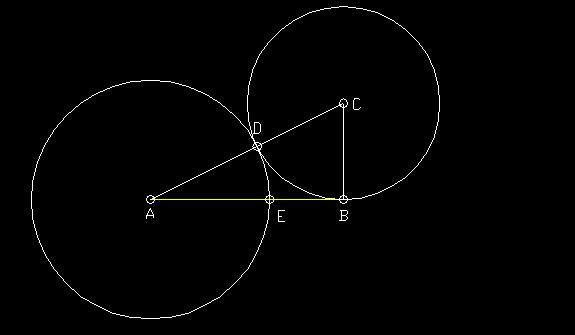
A Golden Section
Given a line AB, construct a point E on AB so that AE/EB=The Golden Ratio.
Step 1. At point B, draw a perpendicular line BC, BC being 1/2 of AB.
Step 2. Draw a line through AC.
Step 3. Draw a circle at point C with radius CB. Circle C intersects AC at D.
Step 4. At point A, draw a circle with radius AD. Circle A intersects AB at E, the Golden Section. AE/EB=Phi=1.618....
The Golden Rectangle
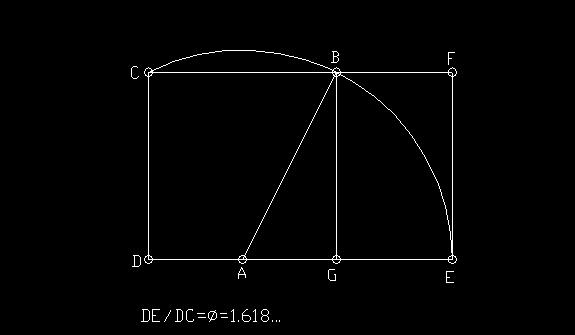
Given a square CBGD, construct the Golden Rectangle.
The sides of the rectangle will be in the proportion of Phi.
Step 1. Find the midpoint A of DG.
Step 2. Draw a circle centered at A and with radius AB.
Step 3. Extend line DG until it intersects circle A at E. The new side DE is the length of the rectangle. DE/DC=Phi.
In the figure, DE divided GE equals Phi. BG/BF also equals Phi. Rectangle BFGE is exactly proportional to CBGD.
The Golden Spiral
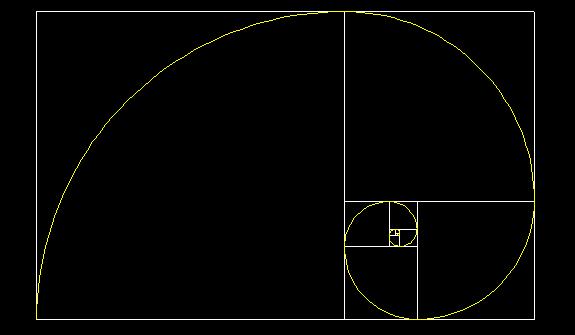
The Golden Spiral is very easy to make. Start with a golden rectangle. Create a golden section along the bottom of the rectangle. Draw a perpendicular line through it. Then create a section of the line you just drew. Keep doing this until it gets too small to draw. Next, draw arcs centered at the golden sections with the radius having the length of the line through the section. You could, if you wanted to, continue drawing the spiral into infinity. It never ends. Look at the picture and you will understand.
The golden spiral also resembles something in nature. Can you guess what? A seashell of course! The Golden ratio is everywhere.
A Fibonacci Spiral
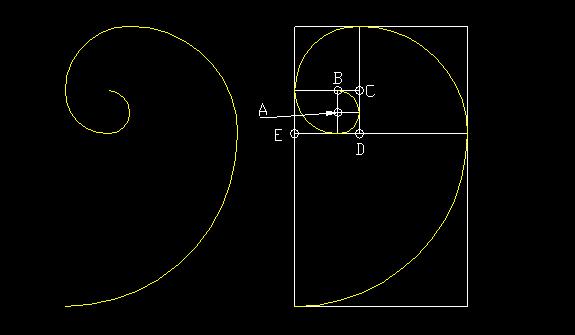
A Fibonacci Spiral is almost the same as a Golden Spiral, except for one difference. A Fibonacci Spiral uses Fibonacci numbers instead of the Golden Mean. Fibonacci numbers are numbers of the pattern 1,2,3,5,8,13,21,34... . If you divide consecutive Fibonaccis, you will get an approximation of Phi.
First, draw two squares with side length of 1 next to each other. Draw a circle centered at A and radius 1. Draw a square with lenth 2, and at point B, draw a circle with radius 2. Then draw a square with side 3,5,8,13 and so on. See the pattern? They're just a bunch of Fibonacci numbers. As you continue the pattern, your rectangle will get closer and closer to the real golden rectangle.
The Golden Triangle and Spiral
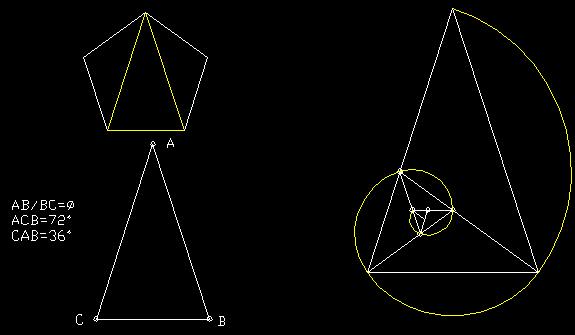
Here's another "Golden" shape, the Golden Triangle. It's an isoceles triangle with base angles equal to 72 degrees and vertex equal to 36 degrees. If you divide the long side by the short side you get Phi or the Golden Ratio. A neat thing is if you bisect one of the 72 angles, you get a smaller one exactly poportional to it. And next to it is an obtuse triangle with angles 36-36-108. You also created another golden section. Look carefully and you'll see it.
An easy way to construct it is to first construct a pentagon. From the top, draw a line down to each side of the base. Look at the diagram above.
To construct the spiral, bisect one of the 72 angles, and draw a circle centered at the 108 angle formed. Keep doing this until it gets to small to draw any more. It will continue on to infinite just like the golden rectangle spiral.
Square
Triangle and Hexagon
Pentagon
Heptagon
Nonagon
Pentadecagon
Heptadecagon
N-Gon
Squaring a Circle
Basic Constructions
Click to change background:


© 2001 Robin Hu